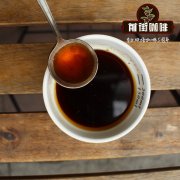Can Costa Rican coffee be made by hand at La Minita Manor, Costa Rica?

Professional coffee knowledge exchange more coffee bean information please follow the coffee workshop (Wechat official account cafe_style)
La Minita International Coffee Export Co., Ltd., named after La Minita Manor (Hacienda La Minita), the flagship estate in Tarazu, Costa Rica. In addition to the flagship estates in Costa Rica, Raminita also offers raw coffee beans from all over the world. Raminita vertically integrates their farms and processing plants around the country to give the coffee a consistent and stable quality and flavor. And focus on staff in the world's top producing areas and places of origin to ensure that the coffee reaches the high quality of Raminita export.
Dota belongs to an independent small producing area in Tarrazu, which is not close to the coffee planting areas in other Tarrazu producing areas, so different climatic conditions, topography and unique soil make the beans in Dota producing areas show a different flavor from Tarrazu producing areas.
Hacienda La Minita is located in the famous Tarrazu producing area of Costa Rica. Due to its excellent geographical environment and microclimate, the beans of La Minita have a more balanced and fragrant taste than other Tarrazu coffee. Although the land in the manor has differences in elevation and temperature, fortunately, the river around the manor reduces the cooling effect, and the farm faces to the west and can slowly heat up in the morning and cool slowly in the evening. but also because of this unique geographical environment has formed a unique advantage. Four varieties of coffee trees, Caturra, Caturra red, Caturra yellow and Hibridoru, were planted on about 680 acres of Laminita manor. after years of experimental statistical analysis and cup quality testing, Laminita Manor decided to mainly adopt Caturra varieties and continue to retain a small number of old Hibrido varieties. Although La Minita in each acre planted about 2500 coffee trees, it still decided on the number of coffee trees according to geographical characteristics and coffee species.
La Minita currently has a total of about 1.7 million trees, and La Minita adopts a five-year knockout system. After three rounds of pruning (that is, 15 years later), the coffee tree resources are almost exhausted, when La Minita will remove new trees from its own coffee nursery to replace it; the nursery is located in a well-protected place on the estate, and the new trees planted in the nursery will be planted in the nursery for a year before they are transplanted to the production farm. La Minita uses fast-growing and broad-leaved "Pror" trees as coffee shade trees. These trees will choose different planting densities according to the demand for sunlight and temperature control in the production area, and will be adjusted according to the demand. All the soils in the manor are tested twice a year, and according to the above-mentioned test results, decide how to fertilize the soil, about three times a year, for economic and environmental considerations and reasons.
At La Minita Manor, the number of pests is greatly limited because of its climate and altitude. In addition to the non-use of pesticides, the most important thing is considerable planting and weeding techniques. In La Minita Manor, pesticides are not used, and fortunately, the climate and altitude formed by the geographical advantages of the estate greatly limit the number of pests. Most importantly, through careful planting and weeding techniques, the coffee trees planted by La Minita are strong and healthy, and a few pests do not have much impact on the coffee trees. At the end of the rainy season, cherry fruit ripens, green cherry fruit begins to turn red or yellow, cherry fruit ripens very slowly and unevenly, not as fast and consistent as flowering.
Therefore, the harvest work must be handled more carefully. The ripe cherry fruit will be harvested first, and the immature fruit will be left on the tree for harvest later. The fruit of a coffee tree will be harvested up to five times by La minita due to maturity, and the production season will end after the last harvest, around the end of February. After the production season, all the coffee fruits, whether ripe or immature, are picked to prepare the coffee trees for production in the coming year.
Qianjie recommended cooking parameters:
Hand punch: V60 filter cup small Fuji R440 grinding 3.5, water temperature about 90 degrees
The recommended grinding degree of normal pressure is 4 and the water temperature is 90 ℃.
The recommended siphon grinding degree is 4, and the water temperature is 90 ℃ ~ 91 ℃.
The pressure grinding degree of Philharmonic is recommended to be 3.5, and the water temperature is 90 ℃.
Important Notice :
前街咖啡 FrontStreet Coffee has moved to new addredd:
FrontStreet Coffee Address: 315,Donghua East Road,GuangZhou
Tel:020 38364473
- Prev

Finca Altieri Manor in Panama introduces how to make Panamanian coffee by hand.
Professional coffee knowledge exchange more coffee bean information Please follow Eugene P. Altieri, the owner of Finca Altieri in the coffee workshop (official Wechat account cafe_style). Altieri is an American-born New Yorker who has lived in Panama for more than 40 years and owns two estates, both located in the Poquet producing area (Boquete), one at a relatively low altitude.
- Next

Introduction of Beneficio Brumas del Zurqui of Blooms processing Plant in Costa Rica
Professional coffee knowledge exchange more coffee bean information please follow the coffee workshop (Wechat official account cafe_style) Brumas processing Plant (Beneficio Brumas del Zurqui) was founded by the Rodrguez Carballo family in 1880 and is now managed by Juan Ramn Alvarado Rodrguez, Donna Clomancia Manor (Finca Dona Cl)
Related
- Does Rose Summer choose Blue, Green or Red? Detailed explanation of Rose Summer Coffee plots and Classification in Panamanian Jade Manor
- What is the difference between the origin, producing area, processing plant, cooperative and manor of coffee beans?
- How fine does the espresso powder fit? how to grind the espresso?
- Sca coffee roasting degree color card coffee roasting degree 8 roasting color values what do you mean?
- The practice of lattes: how to make lattes at home
- Introduction to Indonesian Fine Coffee beans-- Java Coffee producing area of Indonesian Arabica Coffee
- How much will the flavor of light and medium roasted rose summer be expressed? What baking level is rose summer suitable for?
- Introduction to the characteristics of washing, sun-drying or wet-planing coffee commonly used in Mantenin, Indonesia
- Price characteristics of Arabica Coffee Bean Starbucks introduction to Manning Coffee Bean Taste producing area Variety Manor
- What is the authentic Yega flavor? What are the flavor characteristics of the really excellent Yejasuffi coffee beans?

